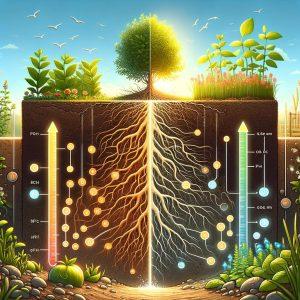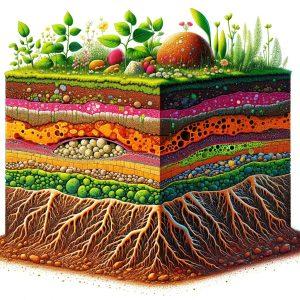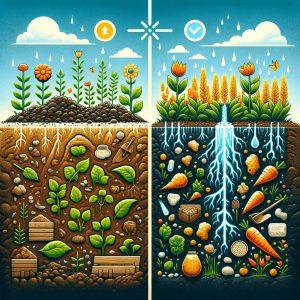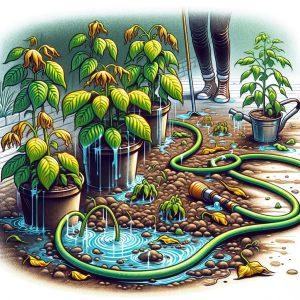Are you struggling with high soil pH levels affecting your plants’ growth? Lowering soil pH is crucial for creating optimal conditions for many plants to thrive. By reducing soil pH, you can unlock essential nutrients and promote healthier plant growth.
One effective method to lower soil pH is by incorporating elemental sulfur, aluminum sulfate, or sulfuric acid into the soil. These materials help to acidify the soil, creating a more favorable environment for acid-loving plants. Additionally, tilling and watering in sulfur can expedite the process, but be cautious not to overwater as this can dilute the application’s effectiveness.
Fall is an ideal time to address high soil pH levels by applying sulfur, allowing ample time for the pH to adjust before the next growing season. Organic matter mulches like wood chips, straw, or compost can also aid in naturally lowering soil pH levels. Consider implementing these strategies to optimize your soil pH and support healthier plant growth.
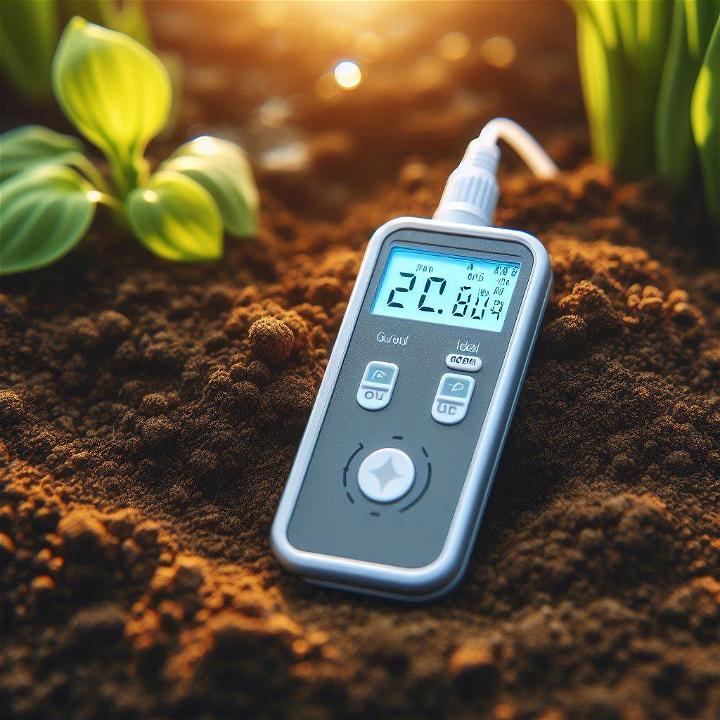
Understanding Soil pH
Soil pH is a crucial factor that influences plant health and growth. It refers to the level of acidity or alkalinity present in the soil. The pH scale ranges from 0 to 14, with 7 being neutral. A soil pH below 7 indicates acidity, while a pH above 7 signifies alkalinity. Understanding soil pH is essential for successful gardening and farming practices.
What is Soil pH?
Soil pH is a measure of the soil’s acidity or alkalinity, determined by the concentration of hydrogen ions present in the soil. A lower pH indicates higher acidity, while a higher pH indicates alkalinity. Different plants have varying pH preferences, so understanding and monitoring soil pH levels is crucial for plant health and growth.
Importance of Soil pH in Plant Growth
The pH of the soil plays a significant role in nutrient availability to plants. It affects the solubility of minerals in the soil, influencing how effectively plants can absorb essential nutrients like nitrogen, phosphorus, and potassium. Imbalanced soil pH can lead to nutrient deficiencies or toxicities in plants, hindering their growth and overall health.
Maintaining the correct soil pH level is vital for optimizing plant growth, root development, and overall productivity. It directly impacts the microbial activity in the soil, which in turn affects nutrient cycling and soil structure. By understanding and managing soil pH, gardeners and farmers can create ideal growing conditions for their plants, leading to healthier and more abundant yields.
Stay tuned for the next sections on how to effectively lower soil pH for improved plant growth.
Methods to Lower Soil pH
The pH level of soil plays a crucial role in the health and growth of plants. When the pH is too high (alkaline), it can impact nutrient availability. Here are some effective methods to lower soil pH:
Using Elemental Sulfur
Elemental sulfur is a commonly used amendment to reduce soil pH. It works by converting to sulfuric acid through microbial activity, gradually lowering the pH level over time (Wisconsin Horticulture).
Applying Aluminum Sulfate
Another option is to apply aluminum sulfate, which is a fast-acting amendment that can quickly reduce soil pH levels. It helps to acidify the soil and improve nutrient availability for plants.
Adding Iron Sulfate
Iron sulfate can also be used to lower soil pH. It not only helps in lowering the pH but also provides essential iron to the plants for healthy growth (Reddit).
Incorporating Organic Matter
Adding organic matter like compost, manure, or peat moss can gradually lower soil pH levels. Organic matter helps create a healthy ecosystem for beneficial microbes that aid in the decomposition process, which in turn can lower pH levels (Aroundtheyard.com Forums).
Using Acidifying Fertilizers
Certain acidifying fertilizers can help in lowering soil pH. These fertilizers contain elements like ammonium, which converts to acids in the soil, gradually reducing the pH level and improving nutrient availability for plants.
Employing Peat Moss
Peat moss is an excellent choice for lowering soil pH over time. It has natural acidic properties that can help in creating a more suitable environment for acid-loving plants. Peat moss can be mixed into the soil or used as a mulch to gradually lower pH levels.
By implementing these methods strategically, you can effectively lower the pH of your soil and create a more favorable environment for plant growth.
Natural Ways to Lower Soil pH
Achieving the optimal pH level in your soil is crucial for the health and growth of your plants. Here are some natural ways to lower soil pH that can help create the ideal growing environment for your garden:
Using Pine Needles
Pine needles are a fantastic natural remedy for lowering soil pH. As they break down, they release acidic compounds that can help acidify the soil. Simply spread a layer of pine needles over the soil surface or incorporate them into the soil. Over time, the acidity of the pine needles will gradually lower the pH levels, benefiting acid-loving plants.
Utilizing Coffee Grounds
Coffee grounds are not only a great addition to your morning routine but also to your garden. When used as a soil amendment, coffee grounds can help lower the pH levels due to their acidic nature. Mix coffee grounds directly into the soil or add them to your compost pile. They will gradually release acids into the soil, making it more acidic over time.
Applying Vinegar Solution
Vinegar is another natural solution for lowering soil pH. A vinegar solution can be diluted and applied directly to the soil around your plants. The acetic acid in vinegar can help acidify the soil, making it more suitable for acid-loving plants. However, it’s essential to use vinegar in moderation to avoid harming beneficial soil organisms.
By incorporating these natural methods into your gardening routine, you can effectively lower the pH of your soil to create a favorable environment for a variety of plants that thrive in acidic conditions. Remember to monitor the pH levels periodically to ensure they remain within the optimal range.
Monitoring and Testing Soil pH
Maintaining the proper pH level in your soil is crucial for healthy plant growth. Regularly monitoring and testing your soil pH can provide valuable insights into its acidity or alkalinity, allowing you to make informed decisions on necessary amendments. Let’s delve into the importance of regular pH testing and how to conduct soil pH tests effectively.
Importance of Regular pH Testing
Regular pH testing is pivotal in ensuring your plants receive the optimal growing conditions. Monitoring soil pH levels allows you to assess if the soil is too acidic or alkaline for your plants’ needs. This information is essential as different plants thrive in varying pH ranges. By staying proactive with pH testing, you can identify issues early on and implement corrective measures promptly to support healthy plant development.
How to Test Soil pH
- Use a Soil pH Testing Kit: Soil pH testing kits are readily available at gardening centers and are simple to use. Follow the instructions provided to obtain accurate pH readings.
- Collect Soil Samples: Select multiple areas in your garden or planting site to gather soil samples. Take samples at varying depths to ensure a comprehensive analysis.
- Prepare the Soil: Remove any debris or rocks from the soil samples. Allow the soil to air dry naturally before testing.
- Conduct the Test: Depending on the kit, add the testing solution to your soil samples and observe the color changes. Match the color to the pH chart provided to determine the soil pH level.
- Interpret Results: Once you have the pH reading, assess if the soil pH falls within the ideal range for your plants. If adjustments are needed, consider adding organic matter or specific soil amendments to lower or raise the pH accordingly.
By regularly monitoring and testing your soil pH, you can effectively manage your garden’s pH levels and create an environment where your plants can thrive. Remember, the key is to maintain a healthy soil pH balance to support robust plant growth and vitality.
FAQs
So you’re looking to lower the pH of your soil, but you might have some questions about the process. Let’s address some common FAQs to help you navigate this task with ease.
What exactly lowers the pH of soil?
The pH of soil can be effectively reduced by incorporating materials like elemental sulfur, aluminum sulfate, or sulfuric acid into the soil. These agents work to decrease the pH level, creating a more acidic environment that is conducive to certain plants’ growth.
How quickly can I expect to see results when lowering soil pH?
The rate at which you’ll see a change in soil pH largely depends on the method you choose to lower it. For instance, adding elemental sulfur and tilling it into the soil can yield faster results compared to other methods. However, it’s essential to be patient as soil pH adjustments may take some time to fully take effect.
Can organic matter help in lowering soil pH naturally?
Yes, organic matter can play a role in lowering soil pH naturally. Incorporating materials like wood chips, straw, compost, or composted manure can gradually help to decrease pH levels over time. Organic matter not only aids in pH reduction but also contributes to soil health and fertility.
How often should I test my soil pH after attempting to lower it?
It’s advisable to monitor your soil pH periodically after initiating pH-lowering measures. Conducting soil tests at regular intervals will enable you to track the effectiveness of the methods you’re using and make adjustments if needed. Remember, maintaining optimal pH levels is key to ensuring healthy plant growth.
Are there any natural remedies to lower soil pH without chemical additives?
Aside from chemical options, you can explore natural remedies to lower soil pH. For instance, incorporating peat moss into the soil can help in gradually decreasing pH levels. Additionally, practices like mulching with organic materials can aid in creating a more acidic soil environment over time.
By addressing these common questions, you’ll be better equipped to tackle the task of lowering the pH of your soil effectively and sustainably.
Conclusion
Lowering soil pH is a crucial aspect of gardening and farming to ensure optimal plant growth and nutrient availability. By understanding the methods and substances that can effectively lower soil pH, you can create a more suitable environment for your plants to thrive.
Recap of Methods to Lower Soil pH
- Elemental Sulfur: Adding elemental sulfur to the soil is a common method to decrease pH levels gradually over time. This substance interacts with soil bacteria to produce sulfuric acid, effectively lowering pH.
- Aluminum Sulfate: Another option is to use aluminum sulfate, which can provide a more immediate reduction in soil pH. However, it’s essential to follow application guidelines to prevent over-acidification.
- Sulfuric Acid: In cases where a rapid decrease in pH is required, sulfuric acid can be used carefully. This method should be approached with caution due to the strong acidic nature of sulfuric acid.
Importance of Monitoring Soil pH
Regularly monitoring the pH of your soil is essential to ensure that it remains within the optimal range for your specific plants. Testing kits are readily available and can help you determine if adjustments are necessary to maintain a healthy growing environment.
Seeking Professional Advice
If you’re unsure about how to proceed or if your soil requires significant pH adjustment, consulting with a local agricultural extension office or a professional gardener can provide valuable guidance. These experts can offer tailored recommendations based on your soil composition and plant species.
Continuous Care for Healthy Soil
Remember that soil pH is just one aspect of maintaining healthy soil. Incorporating organic matter, practicing crop rotation, and proper irrigation techniques are also crucial for the overall well-being of your garden or farm.
By implementing the right strategies to lower soil pH and keeping a proactive approach to soil health, you can create an environment where your plants thrive and flourish.
Explore More About Soil: Relevant Articles
Discover a wealth of information on soil with our articles and resources. Dive deeper into the world of soil science today!
- Adding Phosphorus to Soil: Elevate your garden’s vitality with practical methods to add phosphorus to soil, ensuring lush plant growth.
- Loam Soil Purchasing: Beginners can enhance their gardens by learning where to buy loam soil through our detailed guide.
- Topsoil Benefits: Delve into what is topsoil and its critical uses and benefits for enriching your garden environment.
- Top Soil Gardening Mistakes: Avoid common pitfalls in gardening with our guide on top soil mistakes to avoid for a thriving garden.
- Soil Types Guide: Our comprehensive guide on the different types of soil offers insights into selecting the right soil for your garden.
- Natural Garden Growth: Promote natural plant health with our soil amendments guide, focusing on organic gardening techniques.
- Raising Soil pH Methods: Learn easy ways to raise soil pH for healthier plants and a more vibrant garden.
- DIY Soil pH Testing: Our easy guide shows how to test soil pH at home, a crucial step for garden care.
- Ultimate Loam Soil Guide: Uncover the benefits of loam soil in our ultimate guide to what is loam soil, ideal for gardening success.
- Importance of Soil: Explore why soil is important and its indispensable role in our ecosystem for sustaining life.
- Understanding Soil Composition: Gain insights into what is soil, including its composition, types, and functions, for better gardening outcomes.

